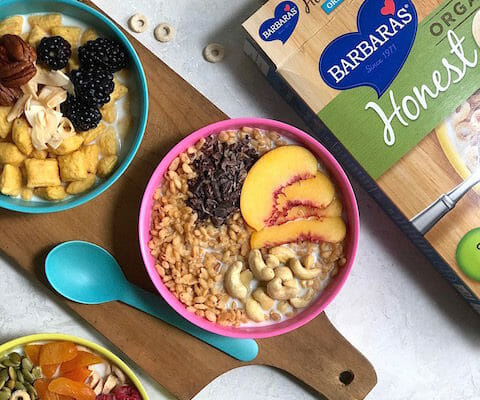Breakfast Cereal Hacks to Build a Better Bowl

Thank you to Barbara's for sponsoring this post
When I was a kid, breakfast cereal was a permanent fixture in our pantry, something we ate several times a week under a pool of two percent milk. My mom never bought what she referred to as “sugar cereals”, festooned with mini marshmallows in a rainbow of colors with toy prizes at the bottom of every box. Of course now I’m grateful that my mornings weren’t fueled by sugar and artificial sweeteners, and I’ve raised my own children with the same cereal ground rules. With that in mind, I figured I’d share some breakfast cereal hacks to make the most of every bowl, from the type of cereal you choose to what you pour and pile over it. You can take your breakfast from good to great with a few little tweaks.
The Cereal
First up is to buy a quality cereal. While supermarket options are endless, much of what’s out there doesn’t add up to a healthy breakfast.
- Look for cereals with whole grains among the ingredients, indicating that it’s less processed with more nutrients. Barbara’s Brown Rice Crisps, for example, features Organic Whole Grain Brown Rice as the first item on the label.
- Keep an eye on calories because some cereals pack a lot of them into a small portion.
- Read the label to see how fiber and sugar stack up. Barbara’s Organic Honest O’s, for example, has 4 grams of fiber and 1 gram of sugar per serving. Their popular Puffins cereal delivers 5 grams of fiber with 5 grams of sugar.
- If you’re gluten-free, be sure the cereal is, too. Some brands made with gluten-free grains are not gluten-free certified, so be sure the box says it’s so.
- If eating non-GMO is a priority, know that any organic cereal qualifies. Otherwise, look for the Non-GMO Product Verified label on the box.
The Milk
With so many options in the milk case these days, it’s hard to know the best one to top your bowl.
- If you prefer cow’s milk, consider going with low-fat to keep saturated fat in check. The exception? If you have a toddler at home, since children under two benefit from the extra fat in whole milk. Those with a lactose intolerance can give lactose-free milk a whirl.
- If you’re looking for a plant-based milk, such as almond or oat, consider a calcium-fortified brand, since most plant milks are not naturally rich in calcium. Also, peruse the list of ingredients to avoid any added sugar, aiming for an unsweetened variety.
- Plenty of protein at breakfast is key to keep you (and your kids) filled up longer. Unfortunately, most plant milks don’t offer much in the way of protein. Soy milk and pea milk are the exception, so consider making one of those your breakfast pour.
- Think outside the box and top your cereal with kefir instead of milk. It’s akin to pourable yogurt and is high in both protein and calcium (with a boatload of gut-healthy probiotics to boot).
The Toppings
Take your cold cereal game up a notch by raiding your fridge and pantry for creative toppings that can add flavor, color, texture, and good nutrition.
Berries — Raspberries, strawberries, blackberries, blueberries, and wild blueberries all deliver fiber, antioxidants and vitamin C. Best of all, no peeling, slicing, or dicing is required.
Banana — Bananas are a cold cereal classic long known for being rich in potassium. They also happen to be a natural prebiotic, another plus for gut health.
Other Fruits — Virtually any fruit that appeals can top your cereal, including sliced peaches, diced apple, and cubed mango. They add nutrients and natural sweetness.
Seeds — Sunflower seeds, pepitas, hemp seeds, and chia seeds add crunch along with fiber and healthy fats.
Nuts — Nuts add protein, fiber, healthy fats, and a nutrient boost. A few popular ones include sliced almonds, chopped pecans or walnuts, and unsalted peanuts.
Other boosters — Other favorite toppings in our house include cacao nibs, toasted coconut, wheat germ, flax meal, cinnamon, dried fruit, and trail mix.






Comments
03.08.2019 at7:17 AM #
Haley
I love putting fruit in my cereal.
12.16.2024 at3:51 AM #
ssyoutube
I loved these creative cereal hacks! The idea of using cereal as a topping for yogurt and smoothies is genius. Can’t wait to try the savory oatmeal twist too! Thanks for sharing these fun ideas!
12.19.2024 at6:45 AM #
YT MP3
I absolutely love these creative cereal hacks! The idea of using cereal as a topping for yogurt or ice cream is genius. Can’t wait to try the cereal bars recipe with my kids this weekend. Thanks for the inspiration!